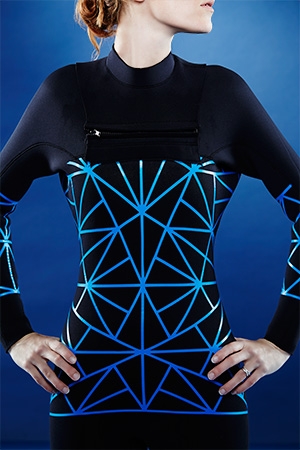Nature inspires seamless performance
Research news
The humble maple leaf was the inspiration for a radically new wetsuit that has been created by Deakin engineers. The designers based their research on the theory of biomimicry, or copying from nature.
“The maple leaf is made from one material, but the veins in the leaf give it structure, which is very common in nature,” said Deakin engineer and product development guru Dr Paul Collins.
Blue bonded polymer strips provide the veins or “exoskeleton” of support to the wetsuit – reducing the number of seams needed from around 20 to only three. This offers surfers a more comfortable and longer life garment and, importantly for commercial viability, production costs will be comparable to standard wetsuits.
Input was provided by some of the world’s best surfers, including former pro surfer Troy “Brooko” Brooks, who were consulted in the early stages of development, along with conversations with Torquay-based surfwear giants Quiksilver and Ripcurl.
In his teaching, Dr Collins has developed an outstanding reputation for encouraging his students to tackle real world problems.
A number of these projects have achieved impressive commercial success, including compression garments co-developed with sportswear company New Balance and action sports company Quiksilver; battery operated heat vests analysed for Ripcurl that are now available in stores around the world; and Deakin’s “proof of concept” carbon fibre smart bike.
For the wetsuit project, Dr Collins joined forces with two students who share a passion for surfing: Deakin PhD student Danny Hurst and Gordon TAFE fashion design student Mark Lee. The trio have designed a wetsuit that provides greater freedom of movement, less chance of rashes and longer life than any others on the market.
“We did a lot of research on human movement, using techniques such as 3D body mapping to identify the stresses and strains on a wetsuit,” said Dr Collins.
Cutting edge technology is also playing a key role in another promising sports design project being undertaken by Dr Collins and PhD student, Nadine Lippa - a USA student currently at Deakin on a scholarship.
Working in partnership with Deakin’s School of Exercise and Nutrition Sciences, the two are exploring the development of bespoke 3D-printed running shoes, which they believe has strong commercial potential.
“Deakin owns one of only a handful of 3D printers in the world that can print the flexible rubber that is used for the soles of running shoes,” said Dr Collins.
“Using biomechanics, we can see how individuals strike the ground and then design shoes for each individual, to improve their running gait and reduce the stress on their knees.”
Dr Paul Collins is passionate about preparing his students for the future – and incorporating “design” in engineering.
“Engineers are increasingly focussed on project-based collaboration, supported by state-of-the-art infrastructure, whether this be 3D printing, virtual reality or body mapping. This is the reality of modern engineering,” he explained.
“Engineering is not just about steel and concrete. It can have applications in many contexts – especially in the area of product development and product design.”
“We try to encourage students - both undergraduates and postgraduates - to take on leadership roles, including developing start-ups. A number of Deakin students have gone on to develop successful companies, such as (carbon fibre wheel manufacturer) Carbon Revolution.”
“With projects such as the wetsuit and 3D shoes, we are extending the boundaries of what makes a university and how we interact with industry but, hopefully, we are preparing our students for the engineering and design of the future.”
Share this story
 Inspired by the maple leaf, designers used blue polymer strips to provide an 'exoskeleton' of support for this high tech wetsuit.
Inspired by the maple leaf, designers used blue polymer strips to provide an 'exoskeleton' of support for this high tech wetsuit.
